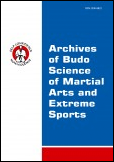2016, Volume 12, Issue 1
Criteria of assessing quick reaction in taekwondo athletes aged 12-25
Zbigniew Bujak1, Dariusz Gierczuk1
1Faculty of Physical Education and Sport in Biała Podlaska, Jozef Pilsudski University of Physical Education in Warsaw, Biała Podlaska, Poland
Author for correspondence: Dariusz Gierczuk; Faculty of Physical Education and Sport in Biała Podlaska, Jozef Pilsudski University of Physical Education in Warsaw, Biała Podlaska, Poland; email: darekgierczuk[at]op.pl
Full text
Abstract
Background and Study Aim: There are a number of factors that determine the effectiveness of technical and tactical activities in combat sports. The cognitive aim of the research was to acquire the knowledge about basic credibility criteria (reliability and diagnostic validity) of selected tests included in Batak Lite as measuring criteria of quick reaction. The application aim was to adapt norms for controlling quick reaction of female and male taekwondo athletes at various levels of sports advancement.
Material& Methods: The research sample was 292 taekwondo athletes (112 females, 180 males); aged 12-25 years. The analysis included 4 selected tests included in Batak Lite. To define the reliability of the tests, the research was carried out twice with an interval of 3-5 days (test-retest). Diagnostic validity was determined with the use of the selected tests included in the Vienna Test System and two main criteria: technical and coordination levels (TC) of competitors and their sports mastery (SM). Norms for female and male athletes were defined in four age categories.
Results: Batak Lite selected tests demonstrated reliability coefficients r >0.50 and, in most cases, validity coefficients r>0.30. Thus, they met the credibility requirements within the applied criteria. The highest validity coefficients were observed in tests of the Vienna Test System assessing choice reaction in females (r = 0.34 to 0.62) and males (r = 0.31 to 0.38) and simple reaction in male competitors only (r = 0.30 to 0.50).
Conclusions: Four Batak Lite tests (I, II, IV and V) displayed sufficient reliability and diagnostic validity, which proved their usefulness when assessing quick reaction of taekwondo athletes.
Key words: Batak Lite, diagnostic validity, norms, reaction time, reliability, test-retest method





